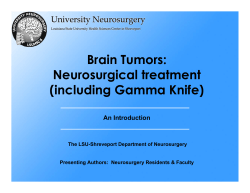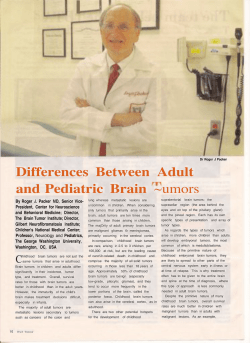
Head and neck tumors
Head and neck tumors Head and neck tumors Tumors of the nasal cavity, paranasal sinuses, oral cavity, nasopharynx, oropharynx, salivary glands, hypopharynx, and larynx. Also tumors of local lymphoid tissue, skin, ear, eye, thyroid gland Risk Smoking and chewing tobacco. Heavy alcohol use. A diet low in fruits and vegetables. Chewing betel quid, a stimulant commonly used in parts of Asia. Being infected with human papilloma virus (HPV). EBV infection. plummer-Vinson syndrome. poor nutrition ill-fitting dentures and other rough surfaces on the teeth P53 mutation Risk Alcohol and tobacco use are the most common risk factors. They are likely synergistic in causing cancer poor diet resulting in vitamin deficiencies Environmental carcinogens include occupational exposures such as nickel BUT- marijuana use was not shown to be associated with oral squamous cell carcinoma (potential protective factor against the development of head and neck squamous cell carcinoma Dietary factors Excessive consumption of processed meats and red meat were associated with increased rates of cancer Betel nut chewing is associated with an increased risk of squamous cell cancer of the head and neck Salted fish (nitrites) – nasopharyngeal carcinoma Consumption of raw and cooked vegetables seemed to be protective. Vitamin E was not found to prevent the development of leukoplakia Human papillomavirus HPV16, is a causal factor for some head and neck squamous cell carcinoma . Approximately 15 to 25% contain genomic DNA from HPV, HPV-positive oropharyngeal cancer, with highest distribution in the tonsils, where HPV DNA is found in (45 to 67%) of the cases, less often in the hypopharynx (13%–25%) least often in the oral cavity (12%–18%) and larynx (3%–7%). cancers of the tonsil may be infected with HPV (25%) Oral sex can result in HPV-related cancer Epstein-Barr virus Associated with nasopharyngeal cancer – high grade. Nasopharyngeal cancer occurs endemically - Mediterranean countries and Asia, EBV antibody titers can be measured to screen high-risk populations Oral cavity – benign epithelial tumors Squamous papilloma less common than in larynx Adults 30-50 yrs HPV 6 and 11 Condyloma young adults – lip, palate Verruciform accuminatum xantoma Middle aged toolder adults Alveolar ridges Prognosis HPV-positive cancers tend to have higher survival rates. The prognosis for people with oropharyngeal cancer depends on the age and health of the person and the stage of the disease. It is important for people with oropharyngeal cancer to have follow-up exams for the rest of their lives as cancer can occur in nearby areas. It is important to eliminate risk factors such as smoking and drinking alcohol, which increase the risk for second cancers Location and type of tumor Oral cavity – precursor (premalignant lesions) HIGH-risk lesions Medium- risk lesions Leukoplakia Erythroplakia speckled Erythroplakia (a mixture of both) chronic hyperplastic candidiasis dysplasia oral submucosal fibrosis syphilitic glossitis sideropenic dysphagia low-risk lesions oral lichen planus discoid lupus erythematosus discoid keratosis congenita Precanceroses Leukoplakia Leukoplakia Leukoplakia High grade dysplasia Erythroplakia Erythroplakia is a general term for red, flat, or eroded velvety lesions that develop in the mouth. In this image, an exophytic squamous cell carcinoma is surrounded by a margin of erythroplakia. Erythroplakia Oral cavity – malignant epithelial tumors Squamous cell carcinoma (the vast majority of head and neck cancers) Conventional (keratinizing) Nonkeratinizing HPV16-95% Asymptomatic neck mass Verrucous carcinoma Endophytic X exophytic X ulcerated Well differentiated, non metastasizing ca Spindle cell ca Adenosquamous carcinoma Neuroendocrice ca High grade, poor prognosis Oral cavity – malignant epithelial tumors Squamous carcinomas – the most common Prognosis associated with location Lip (good prognosis) Tongue (highly aggresive) Mouth floor (highly aggresive) Bucal mucosa (highly aggresive) Gingiva (slow growth) Squamous cell carcinoma Squamous cell carcinoma Squamous cell carcinoma Verrucous carcinoma Oral cavity, mesenchymal tu Vascular Pyegenic granuloma (Lobular capillary hemangioma), lip, tongue, gingival and bucal mucosa Hemangioma Lymphangioma Kaposi´s sarcoma Oral cavity, mesenchymal tu Peripheral ossifying tumor Gingiva, along incisors Peripheral giant cell granuloma Gingiva along incisors, caused by chronic irritation Congenital granular cell epulis Lipoma Osteoma (torus palatinus, mandibularis) Fibrosarcoma Fibroepithelial polyp Fibroepithelial polyp Oral cavity, neuroectodermal tu Neurinoma Neurofibroma Melanocytic nevus Malignant melanoma 60 yrs (20-80) More aggresive than cutaneous Odontogenic tumor Rare, from remnants od dental crest Classification: Epithelial Mesenchymal Mixed Epithelial odontogenic tumors Ameloblastoma (adamantinoma) Calcifying epithelial odontogenic tumor (Pindborg´s tumor), slowly growing, painless, posterior mandible Adenomatoid odontogenic tumor Anterior portion of maxila, younger than 30, females, Squamous odontogenic tumor Malignant ameloblastoma and ameloblastic carcinoma (1% of ameloblastomas) Ameloblastoma (Adamantinoma) The most common Manifestation 20.-40 yrs Mandibula Cystic, ill.defined borders – destructive growts, histology: Histopathology will show cells that have the tendency to move the nucleus away from the basement membrane. This process is referred to as "Reverse Polarization". The follicular type will have outer arrangement of columnar or palisaded ameloblast like cells and inner zone of triangular shaped cells resembling stellate reticulum Commom reccurences May be malignant transformation Ameloblastoma (adamantinoma) Ameloblastoma Ameloblastoma Calcifying epithelial odontogenic tumor Mezenchymal odontogenic tumors Cementoblastoma Cemento-ossifying Odontogenic fibroma fibrom fibroma Odontogenic myxoma Mesenchymal odontogenic tumors Cementoblastoma Childhood Both jaws Cementoblastic proliferation around molars Cementoblastoma Cementoblastoma Mesenchymal odontogenic tumors Odontogenic myxoma arising from embryonic connective tissue associated with tooth formation. consists mainly of spindle shaped cells and scattered collagen fibers distributed through a loose, mucoid material. young people ill - defined borders bone resorption Local infiltration high recurrence rate Mesenchymal odontogenic tumors Odontogenic myxoma Mezenchymal odontogenic tumors Odontogenic myxoma Mesenchymal odontogenic tumors Odontogenic fibroma 55% in mandible 45% in maxilla 2/3 of maxillary tumors found in the anterior segment 4-80 years Females 69% Recurrence rate is low Cellular tumor with minimal ground substance and droplets of calcified matrix representing bone or atubular dentin Small round nests and irregular clusters of epithelial cells Mesenchymal odontogenic tumors Odontogenic fibroma Mixed odontogenic tumors Odontomas Dentinom Ameloblastic fibroma Ameloblastic fibroodontoma Ameloblastic fibrosarcoma Odontogenic carcinosarcoma Mixed odontogenic tumors Ameloblastic fibroma Childhood, adolescence Ameloblastic fibromas are neoplasms of odontogenic epithelium and mesenchymal tissues 2% of odontogenic tumors Uni or multilocular cysts Mixed odontogenic tumors Ameloblastic fibroma Ameloblastic fibroma Mixed odontogenic tumors Odontoma 66% of odontogenic tumors are odontomas hamartoma Between 10. and 20 years More often in maxila compound odontoma - three separate dental tissues (enamel, dentin and cementum) no definitive demarcation of separate tissues between the individual "toothlets Complex odontoma - type is unrecognizable as dental tissues, usually presenting as a radioopaque area with varying densities. Mixed odontogenic tumors Odontoma Mixed odontogenic tumors Odontoma Ameloblastic fibrosarcoma Rare malignant variant of ameloblastic fibroma Invazive and destructive growth, minimal metastases Ameloblastic fibrosarcoma Ameloblastic fibrosarcoma Nonodontogenic tumors of jaws Benign Fibrous dysplasia (polyostotic, monoostotic Juvenile ossifying fibroma Cemento osseous dysplasia Giant fibro-osseous lesions cell lesions Central giant cell granuloma (osteolytic, mostly mandible) Brown tumor of hyperparathyroidism cherubism Salivary gland tumor Salivary gland neoplasms make up 6% of all head and neck tumors Salivary gland neoplasms most commonly appear in the sixth decade of life. Patients with malignant lesions typically present after age 60 years, whereas those with benign lesions usually present when older than 40 years. Benign neoplasms occur more frequently in women than in men, but malignant tumors are distributed equally between the sexes. 80% arise in the parotid glands, 10-15% arise in the submandibular glands, and the remainder arise in the sublingual and minor salivary glands. Almost 50% submandibular gland neoplasms and most sublingual and minor salivary gland tumors are malignant. Most patients with salivary gland neoplasms present with a slowly enlarging painless mass. Laryngeal salivary gland neoplasms may produce airway obstruction, dysphagia, or hoarseness. Minor salivary tumors of the nasal cavity or paranasal sinus can manifest with nasal obstruction or sinusitis. Facial paralysis or other neurologic deficit associated with a salivary gland mass indicates malignancy. Pain may be a feature associated with both benign and malignant tumors. Pain may arise from suppuration or hemorrhage into a mass or from infiltration of a malignancy into adjacent tissue. malignant epithelial tumors benign epithelial tumors soft tissue tumors (Hemangioma) hematolymphoid tumors (e.g. Hodgkin lymphoma) secondary tumors Benign lesion Pleiomorphic adenoma Myoepithelioma Basal cell adenoma Warthin´s tumor Oncocytoma Cystadenoma Canalicular adenoma Malignant tumors Acinic cell carcinoma Mucoepidermoid carcinoma Adenoid cystic carcinoma Salivary duct carcinoma Myoepithelialcarcinoma Carcinoma ex pleimorphic adenoma Squamous cell carcinoma Epi-myoepithelial cyrcinoma Cystadenocarcinoma Salivary gland neoplasms are rare in children. Most tumors (65%) are benign, with hemangiomas being the most common, followed by pleomorphic adenomas. 35% of salivary gland neoplasms are malignant. Mucoepidermoid carcinoma is the most common salivary gland malignancy in children. Pleomorphic adenoma common benign salivary gland neoplasm characterised by neoplastic proliferation of parenchymatous glandular cells along with myoepithelial components, having a malignant potentiality. It is the most common type of salivary gland tumor and the most common tumor of the parotid gland. It derives its name from the architectural pleomorphism (variable appearance) seen by light microscopy. It is also known as "Mixed tumor, which describes its pleomorphic appearance as opposed to its dual origin from epithelial and myoepithelial elements Warthin's tumor the second most common benign parotid tumor. strong association with cigarette smoking. Smokers are at 8 times greater risk of developing Warthin's tumor than the general population Warthin's tumor primarily affects older individuals (age 60–70 years). There is a slight female predilection according to recent studies, but historically it has been associated with a strong male predilection.
© Copyright 2025










![[ PDF ] - journal of evolution of medical and dental sciences](http://cdn1.abcdocz.com/store/data/000665793_1-1b44b52c1191183d3c2335556514c887-250x500.png)